The Saint of the Day
 |
 |
 |
 |
 |
 |
 |
St. Angelus of Jerusalem - May 5
Biographical selection:
Angelus (1185-1220) was born in Jerusalem. When his parents converted, he and his twin brother were baptized. They both entered the Carmelites at age 18.
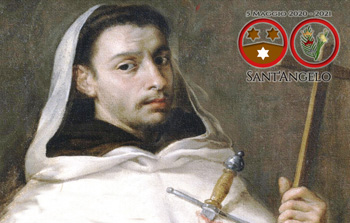 Angelus tenaciously combated the heresies of the Pataria, the Albigensians and the Bulgars. He had a great devotion to St. Francis of Assisi, who he met in Rome in 1219 and informed him of his coming martyrdom. In Leocadia he was murdered by the Cathar Count Berenger after Angelus publicly censured the Count from the pulpit for living incestuously with his sister.
Angelus tenaciously combated the heresies of the Pataria, the Albigensians and the Bulgars. He had a great devotion to St. Francis of Assisi, who he met in Rome in 1219 and informed him of his coming martyrdom. In Leocadia he was murdered by the Cathar Count Berenger after Angelus publicly censured the Count from the pulpit for living incestuously with his sister.
St. Angelus was fatally wounded in the pulpit of the Church of Santi Filippo e Giacomo and expired saying the words: "Into Thy hands I deliver my spirit."
Comments of Prof. Plinio:
St. Angelus was a Carmelite. He was a son of his converted Jewish mother and sincerely embraced the Catholic Faith. We see how false the Nazi affirmation is that when someone belongs to the Jewish race he is not capable of doing anything good and, therefore, of being converted.
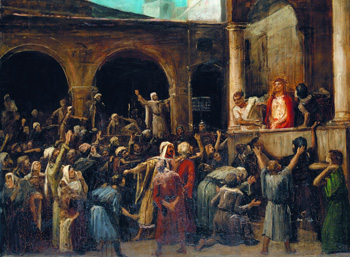 It is clear that over the Jewish people weighs the curse they brought on themselves when they called for the death of Our Lord Jesus Christ, which is the sin of Deicide. But no one can deduce from this that a Jew cannot become a sincere Catholic. To deny that a Jew can be sincerely and entirely Catholic is fallacious.
It is clear that over the Jewish people weighs the curse they brought on themselves when they called for the death of Our Lord Jesus Christ, which is the sin of Deicide. But no one can deduce from this that a Jew cannot become a sincere Catholic. To deny that a Jew can be sincerely and entirely Catholic is fallacious.
The case of St. Angelus who was a great Saint and died a martyr for the Faith and was a son of converted Jews confirms this truth.
Encounter of three Saints
We find St. Angelus of Jerusalem in one of the most beautiful episodes of the History of the Church. It is the famous encounter in a sacristy in Rome of St. Dominic, St. Francis and himself. There is even a famous picture representing the three. They met and each one understood who the other was by divine inspiration. The three knelt and conversed on their knees, such was the veneration that each had for the others.
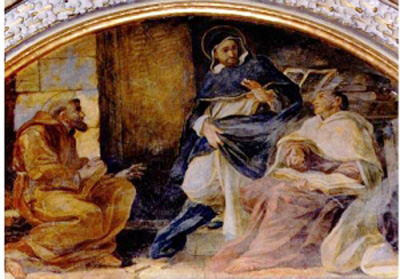
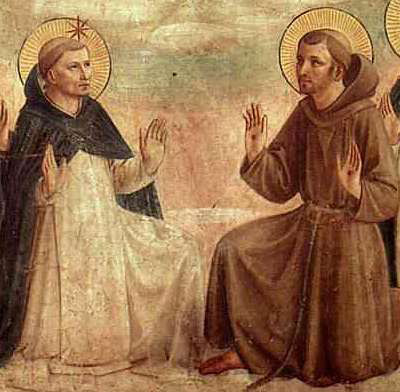 How different this is from the megalomania where each one tries to be more than others! A man with this defect never kneels before others, but does all he can to try to make others kneel before him. The Saints are not made of this dough! They are made of the dough we see here, that is, of those who kneel before others and are delighted to find a superiority to which they render homage.
How different this is from the megalomania where each one tries to be more than others! A man with this defect never kneels before others, but does all he can to try to make others kneel before him. The Saints are not made of this dough! They are made of the dough we see here, that is, of those who kneel before others and are delighted to find a superiority to which they render homage.
The beauty that exists in an encounter of Saints like this comes from the fact that a Saint is a true masterpiece of God.
With the exclusion of the Catholic Church, who has the beauty of all the Saints she engendered, and, of course, with the exclusion of Our Lady, the Saint is the greatest masterpiece of God in the universe of men. A Saint is worth incomparably more than all the treasures of Heaven and Earth, more than all the empires, all the powers, in short, the jewel of the universe is a Saint.
When we think of three Saints meeting, it is something similar to three suns that coexist, with each one multiplying the luminosity of the others by the light it projects over them.
We can say that with human creatures happens an analogous thing to what occurred when God created the universe. God created each thing in the universe; then, when He rested on the seventh day and contemplated what He had done, He saw that each thing was good, but that the whole was better because it was the summation of all those well-done things. The ensemble of three Saints who meet produces a greater beauty than three Saints scattered around the world.
Why is there a special irradiation of sanctity in such an episode? It is because we can realize in such a scene the gifts of each one and how each one shines in some specific way. When the three speak, it is like three different musical instruments playing the same music, but each with its own special tone. This is a magnificent thing!
His martyrdom
You see the good position that St. Angelus took before the feudal lord who lived incestuously with his own sister. St. Angelus was not satisfied in censuring him, but he went to the pulpit to do it. By going to the pulpit he denounced him before all. Therefore, he shook the lord's influence in his county by an action as forceful as the public scandal made by that shocking incestuous behavior.
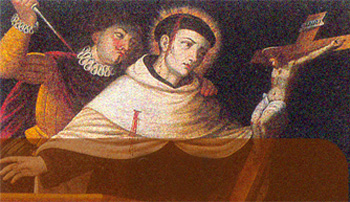 So deep was the blow the noble received from the words of St. Angelus, that he made his retribution by killing St. Angelus in that very pulpit in the church.
So deep was the blow the noble received from the words of St. Angelus, that he made his retribution by killing St. Angelus in that very pulpit in the church.
The Saint died repeating the words of Our Lord when He expired on the Cross: "Into Thy hands I commend My Spirit." St. Angelus really could say those words, because who dies killed by an enemy of the Church is extraordinarily similar to Our Lord who died on the Cross, killed by the Jews of His time.


The Saint of the Day features highlights from the lives of saints based on comments made by the late Prof. Plinio Corrêa de Oliveira. Following the example of St. John Bosco who used to make similar talks for the boys of his College, each evening it was Prof. Plinio’s custom to make a short commentary on the lives of the next day’s saint in a meeting for youth in order to encourage them in the practice of virtue and love for the Catholic Church. TIA thought that its readers could profit from these valuable commentaries.
The texts of both the biographical data and the comments come from personal notes taken by Atila S. Guimarães from 1964 to 1995. Given the fact that the source is a personal notebook, it is possible that at times the biographic notes transcribed here will not rigorously follow the original text read by Prof. Plinio. The commentaries have also been adapted and translated for TIA’s site.
Angelus (1185-1220) was born in Jerusalem. When his parents converted, he and his twin brother were baptized. They both entered the Carmelites at age 18.

St. Angelus of Jerusalem
St. Angelus was fatally wounded in the pulpit of the Church of Santi Filippo e Giacomo and expired saying the words: "Into Thy hands I deliver my spirit."
Comments of Prof. Plinio:
St. Angelus was a Carmelite. He was a son of his converted Jewish mother and sincerely embraced the Catholic Faith. We see how false the Nazi affirmation is that when someone belongs to the Jewish race he is not capable of doing anything good and, therefore, of being converted.

The Jews asked for the guilt of the blood of Christ to fall upon them and their children
The case of St. Angelus who was a great Saint and died a martyr for the Faith and was a son of converted Jews confirms this truth.
Encounter of three Saints
We find St. Angelus of Jerusalem in one of the most beautiful episodes of the History of the Church. It is the famous encounter in a sacristy in Rome of St. Dominic, St. Francis and himself. There is even a famous picture representing the three. They met and each one understood who the other was by divine inspiration. The three knelt and conversed on their knees, such was the veneration that each had for the others.

Above from the left, St. Francis, St. Dominic & St. Angelus; below, another representation of the same encounter

The beauty that exists in an encounter of Saints like this comes from the fact that a Saint is a true masterpiece of God.
With the exclusion of the Catholic Church, who has the beauty of all the Saints she engendered, and, of course, with the exclusion of Our Lady, the Saint is the greatest masterpiece of God in the universe of men. A Saint is worth incomparably more than all the treasures of Heaven and Earth, more than all the empires, all the powers, in short, the jewel of the universe is a Saint.
When we think of three Saints meeting, it is something similar to three suns that coexist, with each one multiplying the luminosity of the others by the light it projects over them.
We can say that with human creatures happens an analogous thing to what occurred when God created the universe. God created each thing in the universe; then, when He rested on the seventh day and contemplated what He had done, He saw that each thing was good, but that the whole was better because it was the summation of all those well-done things. The ensemble of three Saints who meet produces a greater beauty than three Saints scattered around the world.
Why is there a special irradiation of sanctity in such an episode? It is because we can realize in such a scene the gifts of each one and how each one shines in some specific way. When the three speak, it is like three different musical instruments playing the same music, but each with its own special tone. This is a magnificent thing!
His martyrdom
You see the good position that St. Angelus took before the feudal lord who lived incestuously with his own sister. St. Angelus was not satisfied in censuring him, but he went to the pulpit to do it. By going to the pulpit he denounced him before all. Therefore, he shook the lord's influence in his county by an action as forceful as the public scandal made by that shocking incestuous behavior.

St. Angelus was killed by Cathar Count Berenger
The Saint died repeating the words of Our Lord when He expired on the Cross: "Into Thy hands I commend My Spirit." St. Angelus really could say those words, because who dies killed by an enemy of the Church is extraordinarily similar to Our Lord who died on the Cross, killed by the Jews of His time.

 | |
|
|
The texts of both the biographical data and the comments come from personal notes taken by Atila S. Guimarães from 1964 to 1995. Given the fact that the source is a personal notebook, it is possible that at times the biographic notes transcribed here will not rigorously follow the original text read by Prof. Plinio. The commentaries have also been adapted and translated for TIA’s site.


